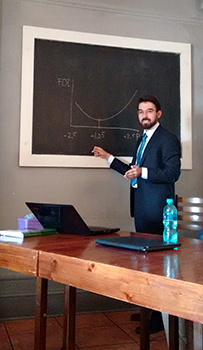
Yani Karavasilev of Osaka University speaking about political stability and Foreign Direct Investment in the Southern African Development Community on day-2 of the joint conference between Osaka University and the University of the Free State.
Photo: Dr Marina da Silva
|
Recently, international delegates convened for the annual Osaka University-University of the Free State (UFS) Conference to discuss issues that affect Africa. This high-profile conference was hosted by the UFS Department of Political Studies and Governance from 22-23 February 2016. The event focused its attention on the state of South Africa (SA) as well as conflict resolution on the African continent.
Topics of discussion
Scholars and policymakers proceed to map out the political, economic, social, and educational trajectory of SA and the African continent. Some of the topics of discussion included SA politics, democracy, economy, foreign policy, race, education, and peace. Delegates also looked at foreign direct investment in the Southern African development community and organisations such as the United Nations and the African Union.
Entangled in turmoil
At the conference, Prof Virgil Hawkins of the Osaka School of International Public Policy, (Osaka University) presented a paper entitled: The role of the local media in Burundi’s 2015 coup attempt. In his presentation, Prof Hawkins analysed the impact made by Radio Publique Africaine, Renaissance, Isanganiro, and Bonesharadio stations during the conflict. Had it not been for these private radio stations, the events leading to, during, and after the coup would not have received international coverage.
Prof Hawkins explained that prior to the coup, “key private radio representatives were called to Musaka military camp” by former intelligence chief, Major General Godefroid Niyombare. He informed them about the coup plot and urged them to report on it. The government in turn accused the independent media of colluding with the coup conspirators. As a result, the radio stations were attacked, coerced to go off-air, and subsequently destroyed. Despite overt efforts by the state to suppress the media’s freedom of expression, it did not succeed.